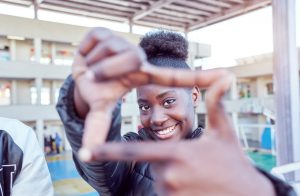Exploring Media Techniques
Discuss a television show that most students are familiar with. It can be an animated or live-action show.
Ask students:
- Do you like this program?
- What do you like best about it?
- Are there any parts you don’t like?
- In this show, what are some things that could really have happened?
- Does anything happen that could never happen in real life?
- Who is your favourite character? (Try to get a consensus about which characters are generally liked.)
- Who is your least favourite character? (Get a consensus about which are disliked.)
Television and movies communicate part of their message without words. The “language” of film includes music, lighting, costumes, props, camera angles, editing, and other techniques, which we understand on an almost subliminal level. We can help children to recognize and to name these elements, and to discover how the makers of TV shows and movies use these techniques to create atmosphere and construct meaning.

Have students try this with a partner:
Stand a few feet apart and look at each other through a frame you’ve made with your hands (see photo at left for an example)
Now “zoom in” for a “close-up” by walking closer to each other until all that’s in your view is your partner’s face.
Try stepping a little closer for an “extreme close-up.” How do you feel about being so close to your partner?
“Zoom” back out to a “medium” shot so that you can see your partner from their chest to the top of their head.
From this distance, try talking about how the different shots feel, and as you are talking, start zooming out again, this time, to a “wide” shot. How does this affect the conversation?
Have students change partners and then try this:
Find a reasonable distance for talking to your partner and get a chair.
Have your partner stand on the chair and look down at you, while you crouch on the ground and look up.
How does your partner look from your low angle?
Trade places.
How does your partner look from the high angles?
Which angle would you choose to illustrate a character who is large and powerful? Which angle is best for creating a character who is small and unimportant?
(If you have already delivered the lesson Camera Angle, remind students of your discussion there.)
Medium shots give you some idea about what’s happening between two people.
Close-ups let you know lots about feelings.
A shot in which the camera seems very close to the subject. In a close-up of a person's face, it is easy to see the facial features and identify the emotion of a character.
A shot where the camera appears to be a short distance away from what we're seeing. In a medium shot of a person, this shot includes the head and upper body.
A shot where the camera seems to be fairly far from what we're seeing. A wide shot of a person will include the whole body and background.
